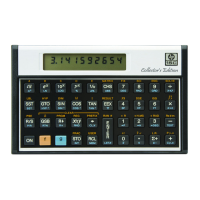i
Introduction
Congratulations! You hold in your hands one of the most capable calculators
HP has ever made—the classic HP-15C, reissued and updated as the HP 15c
Collector’s Edition, the HP 15c CE. Let’s look at how this device came to be
and why its features remain in demand even today.
The Story of HP Calculators
HP introduced the world’s first scientific, pocket calculator, the HP-35, on
February 1, 1972. Single-handedly, it altered forever the market for tools
such as slide rules, books of tables, and mechanical calculators. This
calculating tool computed sine, cosine, and tangent in
degrees as well as logarithms and powers. It also
featured an independent memory register allowing a
value to be reused. The initial version, highly prized by
collectors, had a small red dot that appeared next to
the power switch whenever the calculator was turned
on. This was removed fairly soon after introduction,
since it was obvious the machine was on for two other
reasons: the on/off switch would be in the ON position
and the display would be showing a number in the red
light-emitting diode (LED) display if the batteries were
not yet discharged. For this reason, there are not many
of these early models available and they command
quite a price among collectors.
Notably, the HP-35 used Reverse Polish Notation
(RPN), allowing problems to be solved without the need for parentheses or
remembering pending operations. RPN accomplished this on the HP-35 by
using a 4-level stack where intermediate results are available and, on later
models, a fifth register named LAST X facilitating error recovery during a
calculation. Numbers were keyed in and separated using an v key. No
equals key was to be found anywhere on the keyboard.
The ease of use that RPN brought to problem solving is sometimes lost on
users today, with huge storage space and processing speeds in the gigahertz
range, but it was an incredible advance at the time. For example, consider the
fairly simple problem:
(4 + 3) ÷ (2 + 1)
= ?
HP-35

